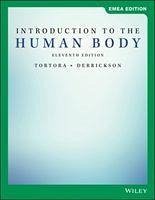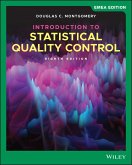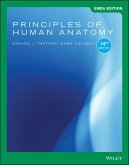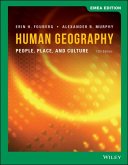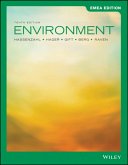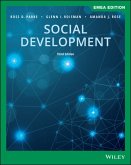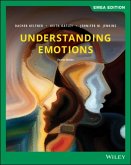Gerard J. Tortora (Bergen Community College), Bryan H. Derrickson (Valencia Community College, Orlando, FL)
Introduction to the Human Body, EMEA Edition
Gerard J. Tortora (Bergen Community College), Bryan H. Derrickson (Valencia Community College, Orlando, FL)
Introduction to the Human Body, EMEA Edition
- Broschiertes Buch
- Merkliste
- Auf die Merkliste
- Bewerten Bewerten
- Teilen
- Produkt teilen
- Produkterinnerung
- Produkterinnerung
A comprehensive approach to learning anatomy and physiology This updated edition offers a balanced introduction to the complexities of the human body. Class-tested pedagogy and figures are seamlessly woven into the narrative to ensure that students gain a solid understanding of the material. Outstanding visual elements provide students with greater clarity and a more engaging learning experience of the structure, functions and organ systems of the body.
Andere Kunden interessierten sich auch für
![Introduction to Statistical Quality Control, EMEA Edition Introduction to Statistical Quality Control, EMEA Edition]() Douglas C. Montgomery (Georgia Institute of Technology)Introduction to Statistical Quality Control, EMEA Edition57,99 €
Douglas C. Montgomery (Georgia Institute of Technology)Introduction to Statistical Quality Control, EMEA Edition57,99 €![Fox and McDonald's Introduction to Fluid Mechanics, EMEA Edition Fox and McDonald's Introduction to Fluid Mechanics, EMEA Edition]() Robert W. Fox (Purdue University)Fox and McDonald's Introduction to Fluid Mechanics, EMEA Edition57,99 €
Robert W. Fox (Purdue University)Fox and McDonald's Introduction to Fluid Mechanics, EMEA Edition57,99 €![Principles of Human Anatomy, EMEA Edition Principles of Human Anatomy, EMEA Edition]() Gerard J. Tortora (Bergen Community College)Principles of Human Anatomy, EMEA Edition76,99 €
Gerard J. Tortora (Bergen Community College)Principles of Human Anatomy, EMEA Edition76,99 €![Human Geography: People, Place, and Culture, EMEA Edition Human Geography: People, Place, and Culture, EMEA Edition]() Erin H. Fouberg (South Dakota State University)Human Geography: People, Place, and Culture, EMEA Edition59,99 €
Erin H. Fouberg (South Dakota State University)Human Geography: People, Place, and Culture, EMEA Edition59,99 €![Environment, EMEA Edition Environment, EMEA Edition]() Hassenzahl, David M., Ph.D. (Las Vegas University of Nevada)Environment, EMEA Edition59,99 €
Hassenzahl, David M., Ph.D. (Las Vegas University of Nevada)Environment, EMEA Edition59,99 €![Social Development, EMEA Edition Social Development, EMEA Edition]() Ross D. Parke (Riverside University of California)Social Development, EMEA Edition66,99 €
Ross D. Parke (Riverside University of California)Social Development, EMEA Edition66,99 €![Understanding Emotions, EMEA Edition Understanding Emotions, EMEA Edition]() Dacher Keltner (Berkeley University of California)Understanding Emotions, EMEA Edition57,99 €
Dacher Keltner (Berkeley University of California)Understanding Emotions, EMEA Edition57,99 €-
-
-
A comprehensive approach to learning anatomy and physiology This updated edition offers a balanced introduction to the complexities of the human body. Class-tested pedagogy and figures are seamlessly woven into the narrative to ensure that students gain a solid understanding of the material. Outstanding visual elements provide students with greater clarity and a more engaging learning experience of the structure, functions and organ systems of the body.
Produktdetails
- Produktdetails
- Verlag: John Wiley & Sons Inc
- 11 ed
- Seitenzahl: 656
- Erscheinungstermin: 15. November 2019
- Englisch
- Abmessung: 217mm x 275mm x 40mm
- Gewicht: 1784g
- ISBN-13: 9781119585466
- ISBN-10: 1119585465
- Artikelnr.: 61322279
- Herstellerkennzeichnung
- Libri GmbH
- Europaallee 1
- 36244 Bad Hersfeld
- gpsr@libri.de
- Verlag: John Wiley & Sons Inc
- 11 ed
- Seitenzahl: 656
- Erscheinungstermin: 15. November 2019
- Englisch
- Abmessung: 217mm x 275mm x 40mm
- Gewicht: 1784g
- ISBN-13: 9781119585466
- ISBN-10: 1119585465
- Artikelnr.: 61322279
- Herstellerkennzeichnung
- Libri GmbH
- Europaallee 1
- 36244 Bad Hersfeld
- gpsr@libri.de
Gerard J. Tortora is Professor of Biology and former Biology Coordinator at Bergen Community College in Paramus, New Jersey, where he teaches human anatomy and physiology as well as microbiology. He received his bachelor's degree in biology from Fairleigh Dickinson University and his master's degree in science education from Montclair State College. He is a member of many professional organizations, including the Human Anatomy and Physiology Society (HAPS), the American Society of Microbiology (ASM), American Association for the Advancement of Science (AAAS), National Education Association (NEA), and the Metropolitan Association of College and University Biologists (MACUB). Bryan H. Derrickson is Professor of Biology at Valencia Community College in Orlando, Florida, where he teaches human anatomy and physiology as well as general biology and human sexuality. He received his bachelor's degree in biology from Morehouse College and his doctorate in cell biology from Duke University. Bryan studied at Duke in the Physiology Division of the Department of Cell Biology, so while his degree is in cell biology, his training focused on physiology. At Valencia, he has served as a member of the Faculty Senate, which is the governing body of the college, and as a member of the Teaching and Learning Academy, which sets the standards for the acquisition of tenure by faculty members. Nationally, he is a member of the Human Anatomy and Physiology Society (HAPS) and the National Association of Biology Teachers (NABT).
1 Organization of the Human Body 1
1.1 Anatomy and Physiology: An Overview 1
1.2 Life Processes 6
1.3 Homeostasis: Maintaining Limits 7
1.4 Aging and Homeostasis 10
1.5 Anatomical Terms 10
1.6 Body Cavities 15
Chapter Review 19
Critical Thinking Applications 20
Answers to Figure Questions 20
2 Introductory Chemistry 21
2.1 Introduction to Chemistry 21
2.2 Chemical Compounds and Life Processes 28
Chapter Review 38
Critical Thinking Applications 39
Answers to Figure Questions 39
3 Cells 40
3.1 A Generalized View of the Cell 40
3.2 The Plasma Membrane 41
3.3 Transport Across the Plasma Membrane 43
3.4 Cytoplasm 48
3.5 Nucleus 54
3.6 Gene Action: Protein Synthesis 56
3.7 Somatic Cell Division 59
3.8 Cellular Diversity 61
3.9 Aging and Cells 61
Chapter Review 64
Critical Thinking Applications 66
Answers to Figure Questions 66
4 Tissues 67
4.1 Types of Tissues 67
4.2 Epithelial Tissue 68
4.3 Connective Tissue 78
4.4 Membranes 86
4.5 Muscular Tissue 88
4.6 Nervous Tissue 88
4.7 Tissue Repair: Restoring Homeostasis 88
4.8 Aging and Tissues 89
Chapter Review 90
Critical Thinking Applications 92
Answers to Figure Questions 92
5 The Integumentary System 93
5.1 Skin 93
5.2 Accessory Structures of the Skin 97
5.3 Functions of the Skin 101
5.4 Skin Wound Healing 102
5.5 Aging and the Integumentary System 104
Chapter Review 109
Critical Thinking Applications 110
Answers to Figure Questions 110
6 The Skeletal System 111
6.1 Functions of Bone and the Skeletal System 111
6.2 Types of Bones 112
6.3 Structure of Bone 112
6.4 Bone Formation 116
6.5 Exercise and Bone Tissue 121
6.6 Divisions of the Skeletal System 122
6.7 Skull: An Overview 124
6.8 Unique Features of the Skull 130
6.9 Vertebral Column 132
6.10 Vertebral Regions 134
6.11 Thorax 137
6.12 Pectoral (Shoulder) Girdle 137
6.13 Upper Limb 139
6.14 Pelvic (Hip) Girdle 142
6.15 Lower Limb 144
6.16 Comparison of Female and Male Skeletons 148
6.17 Aging and the Skeletal System 149
Chapter Review 153
Critical Thinking Applications 155
Answers to Figure Questions 155
7 Joints 156
7.1 Classification of Joints 156
7.2 Fibrous Joints 157
7.3 Cartilaginous Joints 159
7.4 Synovial Joints 159
7.5 Types of Movements at Synovial Joints 161
7.6 Types of Synovial Joints 164
7.7 The Knee Joint 166
7.8 Aging and Joints 169
Chapter Review 171
Critical Thinking Applications 172
Answers to Figure Questions 172
8 The Muscular System 173
8.1 Overview of Muscular Tissue 173
8.2 Skeletal Muscle Tissue 174
8.3 Contraction and Relaxation of Skeletal Muscle 178
8.4 Metabolism of Skeletal Muscle Tissue 183
8.5 Control of Muscle Tension 185
8.6 Exercise and Skeletal Muscle Tissue 186
8.7 Cardiac Muscle Tissue 187
8.8 Smooth Muscle Tissue 187
8.9 Aging and Muscular Tissue 189
8.10 How Skeletal Muscles Produce Movement 189
8.11 Principal Skeletal Muscles 190
Chapter Review 218
Critical Thinking Applications 220
Answers to Figure Questions 221
9 Nervous Tissue 222
9.1 Overview of the Nervous System 222
9.2 Histology of Nervous Tissue 224
9.3 Action Potentials 229
9.4 Synaptic Transmission 233
Chapter Review 236
Critical Thinking Applications 237
Answers to Figure Questions 237
10 Central Nervous System, Spinal Nerves, and Cranial Nerves 238
10.1 Spinal Cord Structure 238
10.2 Spinal Nerves 242
10.3 Spinal Cord Functions 243
10.4 Brain 244
10.5 Cranial Nerves 259
10.6 Aging and the Nervous System 261
Chapter Review 263
Critical Thinking Applications 264
Answers to Figure Questions 264
11 Autonomic Nervous System 265
11.1 Comparison of Somatic and Autonomic Nervous Systems 265
11.2 Structure of the Autonomic Nervous System 267
11.3 Functions of the Autonomic Nervous System 271
Chapter Review 275
Critical Thinking Applications 275
Answers to Figure Questions 275
12 Somatic Senses and Special Senses 276
12.1 Overview of Sensations 276
12.2 Somatic Senses 278
12.3 Olfaction: Sense of Smell 281
12.4 Gustation: Sense of Taste 283
12.5 Vision 285
12.6 Hearing and Equilibrium 294
Chapter Review 302
Critical Thinking Applications 303
Answers to Figure Questions 304
13 The Endocrine System 305
13.1 Introduction 305
13.2 Hormone Action 307
13.3 Hypothalamus and Pituitary Gland 309
13.4 Thyroid Gland 314
13.5 Parathyroid Glands 316
13.6 Pancreatic Islets 317
13.7 Adrenal Glands 322
13.8 Ovaries and Testes 325
13.9 Pineal Gland 325
13.10 Other Hormones 325
13.11 The Stress Response 326
13.12 Aging and the Endocrine System 327
Chapter Review 330
Critical Thinking Applications 332
Answers to Figure Questions 332
14 The Cardiovascular System: Blood 333
14.1 Functions of Blood 333
14.2 Components of Whole Blood 334
14.3 Hemostasis 342
14.4 Blood Groups and Blood Types 344
Chapter Review 348
Critical Thinking Applications 349
Answers to Figure Questions 349
15 The Cardiovascular System: Heart 350
15.1 Structure and Organization of the Heart 350
15.2 Blood Flow and Blood Supply of the Heart 357
15.3 Conduction System of the Heart 359
15.4 Electrocardiogram 360
15.5 The Cardiac Cycle 361
15.6 Cardiac Output 362
15.7 Exercise and the Heart 364
Chapter Review 367
Critical Thinking Applications 368
Answers to Figure Questions 368
16 The Cardiovascular System: Blood Vessels and Circulation 369
16.1 Blood Vessel Structure and Function 369
16.2 Blood Flow Through Blood Vessels 374
16.3 Circulatory Routes 377
16.4 Hepatic Portal and Fetal Circulations 396
16.5 Checking Circulation 399
16.6 Aging and the Cardiovascular System 400
Chapter Review 402
Critical Thinking Applications 404
Answers to Figure Questions 404
17 The Lymphatic System and Immunity 405
17.1 Lymphatic System 406
17.2 Innate Immunity 410
17.3 Adaptive Immunity 413
17.4 Aging and the Immune System 422
Chapter Review 427
Critical Thinking Applications 428
Answers to Figure Questions 428
18 The Respiratory System 429
18.1 Overview of the Respiratory System 429
18.2 Organs of the Respiratory System 430
18.3 Pulmonary Ventilation 438
18.4 Exchange of Oxygen and Carbon Dioxide 441
18.5 Transport of Respiratory Gases 444
18.6 Control of Breathing 446
18.7 Exercise and the Respiratory System 449
18.8 Aging and the Respiratory System 449
Chapter Review 453
Critical Thinking Applications 454
Answers to Figure Questions 454
19 The Digestive System 455
19.1 Overview of the Digestive System 455
19.2 Layers of the GI Tract and the Omentum 457
19.3 Mouth 459
19.4 Pharynx and Esophagus 462
19.5 Stomach 464
19.6 Pancreas 467
19.7 Liver and Gallbladder 468
19.8 Small Intestine 470
19.9 Large Intestine 476
19.10 Phases of Digestion 479
19.11 Aging and the Digestive System 480
Chapter Review 484
Critical Thinking Applications 485
Answers to Figure Questions 486
20 Metabolism and Nutrition 487
20.1 Metabolism 487
20.2 Metabolism and Body Heat 493
20.3 Nutrients 495
Chapter Review 501
Critical Thinking Applications 502
Answers to Figure Questions 502
21 The Urinary System 503
21.1 Overview of the Urinary System 503
21.2 Structure of the Kidneys 505
21.3 Functions of the Nephron 509
21.4 Transportation, Storage, and Elimination of Urine 516
21.5 Aging and the Urinary System 518
Chapter Review 521
Critical Thinking Applications 522
Answers to Figure Questions 522
22 Fluid, Electrolyte, and Acid-Base Balance 523
22.1 Fluid Compartments and Fluid Balance 523
22.2 Electrolytes in Body Fluids 527
22.3 Acid-Base Balance 530
22.4 Aging and Fluid, Electrolyte, and Acid-Base Balance 532
Chapter Review 533
Critical Thinking Applications 534
Answers to Figure Questions 534
23 The Reproductive Systems 535
23.1 Male Reproductive System 535
23.2 Female Reproductive System 544
23.3 The Female Reproductive Cycle 551
23.4 Birth Control Methods and Abortion 554
23.5 Aging and the Reproductive Systems 557
Chapter Review 562
Critical Thinking Applications 564
Answers to Figure Questions 564
24 Development and Inheritance 565
24.1 Embryonic Period 565
24.2 Fetal Period 574
24.3 Maternal Changes During Pregnancy 575
24.4 Exercise and Pregnancy 577
24.5 Labor and Delivery 577
24.6 Lactation 578
24.7 Inheritance 579
Chapter Review 584
Critical Thinking Applications 585
Answers to Figure Questions 585
1.1 Anatomy and Physiology: An Overview 1
1.2 Life Processes 6
1.3 Homeostasis: Maintaining Limits 7
1.4 Aging and Homeostasis 10
1.5 Anatomical Terms 10
1.6 Body Cavities 15
Chapter Review 19
Critical Thinking Applications 20
Answers to Figure Questions 20
2 Introductory Chemistry 21
2.1 Introduction to Chemistry 21
2.2 Chemical Compounds and Life Processes 28
Chapter Review 38
Critical Thinking Applications 39
Answers to Figure Questions 39
3 Cells 40
3.1 A Generalized View of the Cell 40
3.2 The Plasma Membrane 41
3.3 Transport Across the Plasma Membrane 43
3.4 Cytoplasm 48
3.5 Nucleus 54
3.6 Gene Action: Protein Synthesis 56
3.7 Somatic Cell Division 59
3.8 Cellular Diversity 61
3.9 Aging and Cells 61
Chapter Review 64
Critical Thinking Applications 66
Answers to Figure Questions 66
4 Tissues 67
4.1 Types of Tissues 67
4.2 Epithelial Tissue 68
4.3 Connective Tissue 78
4.4 Membranes 86
4.5 Muscular Tissue 88
4.6 Nervous Tissue 88
4.7 Tissue Repair: Restoring Homeostasis 88
4.8 Aging and Tissues 89
Chapter Review 90
Critical Thinking Applications 92
Answers to Figure Questions 92
5 The Integumentary System 93
5.1 Skin 93
5.2 Accessory Structures of the Skin 97
5.3 Functions of the Skin 101
5.4 Skin Wound Healing 102
5.5 Aging and the Integumentary System 104
Chapter Review 109
Critical Thinking Applications 110
Answers to Figure Questions 110
6 The Skeletal System 111
6.1 Functions of Bone and the Skeletal System 111
6.2 Types of Bones 112
6.3 Structure of Bone 112
6.4 Bone Formation 116
6.5 Exercise and Bone Tissue 121
6.6 Divisions of the Skeletal System 122
6.7 Skull: An Overview 124
6.8 Unique Features of the Skull 130
6.9 Vertebral Column 132
6.10 Vertebral Regions 134
6.11 Thorax 137
6.12 Pectoral (Shoulder) Girdle 137
6.13 Upper Limb 139
6.14 Pelvic (Hip) Girdle 142
6.15 Lower Limb 144
6.16 Comparison of Female and Male Skeletons 148
6.17 Aging and the Skeletal System 149
Chapter Review 153
Critical Thinking Applications 155
Answers to Figure Questions 155
7 Joints 156
7.1 Classification of Joints 156
7.2 Fibrous Joints 157
7.3 Cartilaginous Joints 159
7.4 Synovial Joints 159
7.5 Types of Movements at Synovial Joints 161
7.6 Types of Synovial Joints 164
7.7 The Knee Joint 166
7.8 Aging and Joints 169
Chapter Review 171
Critical Thinking Applications 172
Answers to Figure Questions 172
8 The Muscular System 173
8.1 Overview of Muscular Tissue 173
8.2 Skeletal Muscle Tissue 174
8.3 Contraction and Relaxation of Skeletal Muscle 178
8.4 Metabolism of Skeletal Muscle Tissue 183
8.5 Control of Muscle Tension 185
8.6 Exercise and Skeletal Muscle Tissue 186
8.7 Cardiac Muscle Tissue 187
8.8 Smooth Muscle Tissue 187
8.9 Aging and Muscular Tissue 189
8.10 How Skeletal Muscles Produce Movement 189
8.11 Principal Skeletal Muscles 190
Chapter Review 218
Critical Thinking Applications 220
Answers to Figure Questions 221
9 Nervous Tissue 222
9.1 Overview of the Nervous System 222
9.2 Histology of Nervous Tissue 224
9.3 Action Potentials 229
9.4 Synaptic Transmission 233
Chapter Review 236
Critical Thinking Applications 237
Answers to Figure Questions 237
10 Central Nervous System, Spinal Nerves, and Cranial Nerves 238
10.1 Spinal Cord Structure 238
10.2 Spinal Nerves 242
10.3 Spinal Cord Functions 243
10.4 Brain 244
10.5 Cranial Nerves 259
10.6 Aging and the Nervous System 261
Chapter Review 263
Critical Thinking Applications 264
Answers to Figure Questions 264
11 Autonomic Nervous System 265
11.1 Comparison of Somatic and Autonomic Nervous Systems 265
11.2 Structure of the Autonomic Nervous System 267
11.3 Functions of the Autonomic Nervous System 271
Chapter Review 275
Critical Thinking Applications 275
Answers to Figure Questions 275
12 Somatic Senses and Special Senses 276
12.1 Overview of Sensations 276
12.2 Somatic Senses 278
12.3 Olfaction: Sense of Smell 281
12.4 Gustation: Sense of Taste 283
12.5 Vision 285
12.6 Hearing and Equilibrium 294
Chapter Review 302
Critical Thinking Applications 303
Answers to Figure Questions 304
13 The Endocrine System 305
13.1 Introduction 305
13.2 Hormone Action 307
13.3 Hypothalamus and Pituitary Gland 309
13.4 Thyroid Gland 314
13.5 Parathyroid Glands 316
13.6 Pancreatic Islets 317
13.7 Adrenal Glands 322
13.8 Ovaries and Testes 325
13.9 Pineal Gland 325
13.10 Other Hormones 325
13.11 The Stress Response 326
13.12 Aging and the Endocrine System 327
Chapter Review 330
Critical Thinking Applications 332
Answers to Figure Questions 332
14 The Cardiovascular System: Blood 333
14.1 Functions of Blood 333
14.2 Components of Whole Blood 334
14.3 Hemostasis 342
14.4 Blood Groups and Blood Types 344
Chapter Review 348
Critical Thinking Applications 349
Answers to Figure Questions 349
15 The Cardiovascular System: Heart 350
15.1 Structure and Organization of the Heart 350
15.2 Blood Flow and Blood Supply of the Heart 357
15.3 Conduction System of the Heart 359
15.4 Electrocardiogram 360
15.5 The Cardiac Cycle 361
15.6 Cardiac Output 362
15.7 Exercise and the Heart 364
Chapter Review 367
Critical Thinking Applications 368
Answers to Figure Questions 368
16 The Cardiovascular System: Blood Vessels and Circulation 369
16.1 Blood Vessel Structure and Function 369
16.2 Blood Flow Through Blood Vessels 374
16.3 Circulatory Routes 377
16.4 Hepatic Portal and Fetal Circulations 396
16.5 Checking Circulation 399
16.6 Aging and the Cardiovascular System 400
Chapter Review 402
Critical Thinking Applications 404
Answers to Figure Questions 404
17 The Lymphatic System and Immunity 405
17.1 Lymphatic System 406
17.2 Innate Immunity 410
17.3 Adaptive Immunity 413
17.4 Aging and the Immune System 422
Chapter Review 427
Critical Thinking Applications 428
Answers to Figure Questions 428
18 The Respiratory System 429
18.1 Overview of the Respiratory System 429
18.2 Organs of the Respiratory System 430
18.3 Pulmonary Ventilation 438
18.4 Exchange of Oxygen and Carbon Dioxide 441
18.5 Transport of Respiratory Gases 444
18.6 Control of Breathing 446
18.7 Exercise and the Respiratory System 449
18.8 Aging and the Respiratory System 449
Chapter Review 453
Critical Thinking Applications 454
Answers to Figure Questions 454
19 The Digestive System 455
19.1 Overview of the Digestive System 455
19.2 Layers of the GI Tract and the Omentum 457
19.3 Mouth 459
19.4 Pharynx and Esophagus 462
19.5 Stomach 464
19.6 Pancreas 467
19.7 Liver and Gallbladder 468
19.8 Small Intestine 470
19.9 Large Intestine 476
19.10 Phases of Digestion 479
19.11 Aging and the Digestive System 480
Chapter Review 484
Critical Thinking Applications 485
Answers to Figure Questions 486
20 Metabolism and Nutrition 487
20.1 Metabolism 487
20.2 Metabolism and Body Heat 493
20.3 Nutrients 495
Chapter Review 501
Critical Thinking Applications 502
Answers to Figure Questions 502
21 The Urinary System 503
21.1 Overview of the Urinary System 503
21.2 Structure of the Kidneys 505
21.3 Functions of the Nephron 509
21.4 Transportation, Storage, and Elimination of Urine 516
21.5 Aging and the Urinary System 518
Chapter Review 521
Critical Thinking Applications 522
Answers to Figure Questions 522
22 Fluid, Electrolyte, and Acid-Base Balance 523
22.1 Fluid Compartments and Fluid Balance 523
22.2 Electrolytes in Body Fluids 527
22.3 Acid-Base Balance 530
22.4 Aging and Fluid, Electrolyte, and Acid-Base Balance 532
Chapter Review 533
Critical Thinking Applications 534
Answers to Figure Questions 534
23 The Reproductive Systems 535
23.1 Male Reproductive System 535
23.2 Female Reproductive System 544
23.3 The Female Reproductive Cycle 551
23.4 Birth Control Methods and Abortion 554
23.5 Aging and the Reproductive Systems 557
Chapter Review 562
Critical Thinking Applications 564
Answers to Figure Questions 564
24 Development and Inheritance 565
24.1 Embryonic Period 565
24.2 Fetal Period 574
24.3 Maternal Changes During Pregnancy 575
24.4 Exercise and Pregnancy 577
24.5 Labor and Delivery 577
24.6 Lactation 578
24.7 Inheritance 579
Chapter Review 584
Critical Thinking Applications 585
Answers to Figure Questions 585
1 Organization of the Human Body 1
1.1 Anatomy and Physiology: An Overview 1
1.2 Life Processes 6
1.3 Homeostasis: Maintaining Limits 7
1.4 Aging and Homeostasis 10
1.5 Anatomical Terms 10
1.6 Body Cavities 15
Chapter Review 19
Critical Thinking Applications 20
Answers to Figure Questions 20
2 Introductory Chemistry 21
2.1 Introduction to Chemistry 21
2.2 Chemical Compounds and Life Processes 28
Chapter Review 38
Critical Thinking Applications 39
Answers to Figure Questions 39
3 Cells 40
3.1 A Generalized View of the Cell 40
3.2 The Plasma Membrane 41
3.3 Transport Across the Plasma Membrane 43
3.4 Cytoplasm 48
3.5 Nucleus 54
3.6 Gene Action: Protein Synthesis 56
3.7 Somatic Cell Division 59
3.8 Cellular Diversity 61
3.9 Aging and Cells 61
Chapter Review 64
Critical Thinking Applications 66
Answers to Figure Questions 66
4 Tissues 67
4.1 Types of Tissues 67
4.2 Epithelial Tissue 68
4.3 Connective Tissue 78
4.4 Membranes 86
4.5 Muscular Tissue 88
4.6 Nervous Tissue 88
4.7 Tissue Repair: Restoring Homeostasis 88
4.8 Aging and Tissues 89
Chapter Review 90
Critical Thinking Applications 92
Answers to Figure Questions 92
5 The Integumentary System 93
5.1 Skin 93
5.2 Accessory Structures of the Skin 97
5.3 Functions of the Skin 101
5.4 Skin Wound Healing 102
5.5 Aging and the Integumentary System 104
Chapter Review 109
Critical Thinking Applications 110
Answers to Figure Questions 110
6 The Skeletal System 111
6.1 Functions of Bone and the Skeletal System 111
6.2 Types of Bones 112
6.3 Structure of Bone 112
6.4 Bone Formation 116
6.5 Exercise and Bone Tissue 121
6.6 Divisions of the Skeletal System 122
6.7 Skull: An Overview 124
6.8 Unique Features of the Skull 130
6.9 Vertebral Column 132
6.10 Vertebral Regions 134
6.11 Thorax 137
6.12 Pectoral (Shoulder) Girdle 137
6.13 Upper Limb 139
6.14 Pelvic (Hip) Girdle 142
6.15 Lower Limb 144
6.16 Comparison of Female and Male Skeletons 148
6.17 Aging and the Skeletal System 149
Chapter Review 153
Critical Thinking Applications 155
Answers to Figure Questions 155
7 Joints 156
7.1 Classification of Joints 156
7.2 Fibrous Joints 157
7.3 Cartilaginous Joints 159
7.4 Synovial Joints 159
7.5 Types of Movements at Synovial Joints 161
7.6 Types of Synovial Joints 164
7.7 The Knee Joint 166
7.8 Aging and Joints 169
Chapter Review 171
Critical Thinking Applications 172
Answers to Figure Questions 172
8 The Muscular System 173
8.1 Overview of Muscular Tissue 173
8.2 Skeletal Muscle Tissue 174
8.3 Contraction and Relaxation of Skeletal Muscle 178
8.4 Metabolism of Skeletal Muscle Tissue 183
8.5 Control of Muscle Tension 185
8.6 Exercise and Skeletal Muscle Tissue 186
8.7 Cardiac Muscle Tissue 187
8.8 Smooth Muscle Tissue 187
8.9 Aging and Muscular Tissue 189
8.10 How Skeletal Muscles Produce Movement 189
8.11 Principal Skeletal Muscles 190
Chapter Review 218
Critical Thinking Applications 220
Answers to Figure Questions 221
9 Nervous Tissue 222
9.1 Overview of the Nervous System 222
9.2 Histology of Nervous Tissue 224
9.3 Action Potentials 229
9.4 Synaptic Transmission 233
Chapter Review 236
Critical Thinking Applications 237
Answers to Figure Questions 237
10 Central Nervous System, Spinal Nerves, and Cranial Nerves 238
10.1 Spinal Cord Structure 238
10.2 Spinal Nerves 242
10.3 Spinal Cord Functions 243
10.4 Brain 244
10.5 Cranial Nerves 259
10.6 Aging and the Nervous System 261
Chapter Review 263
Critical Thinking Applications 264
Answers to Figure Questions 264
11 Autonomic Nervous System 265
11.1 Comparison of Somatic and Autonomic Nervous Systems 265
11.2 Structure of the Autonomic Nervous System 267
11.3 Functions of the Autonomic Nervous System 271
Chapter Review 275
Critical Thinking Applications 275
Answers to Figure Questions 275
12 Somatic Senses and Special Senses 276
12.1 Overview of Sensations 276
12.2 Somatic Senses 278
12.3 Olfaction: Sense of Smell 281
12.4 Gustation: Sense of Taste 283
12.5 Vision 285
12.6 Hearing and Equilibrium 294
Chapter Review 302
Critical Thinking Applications 303
Answers to Figure Questions 304
13 The Endocrine System 305
13.1 Introduction 305
13.2 Hormone Action 307
13.3 Hypothalamus and Pituitary Gland 309
13.4 Thyroid Gland 314
13.5 Parathyroid Glands 316
13.6 Pancreatic Islets 317
13.7 Adrenal Glands 322
13.8 Ovaries and Testes 325
13.9 Pineal Gland 325
13.10 Other Hormones 325
13.11 The Stress Response 326
13.12 Aging and the Endocrine System 327
Chapter Review 330
Critical Thinking Applications 332
Answers to Figure Questions 332
14 The Cardiovascular System: Blood 333
14.1 Functions of Blood 333
14.2 Components of Whole Blood 334
14.3 Hemostasis 342
14.4 Blood Groups and Blood Types 344
Chapter Review 348
Critical Thinking Applications 349
Answers to Figure Questions 349
15 The Cardiovascular System: Heart 350
15.1 Structure and Organization of the Heart 350
15.2 Blood Flow and Blood Supply of the Heart 357
15.3 Conduction System of the Heart 359
15.4 Electrocardiogram 360
15.5 The Cardiac Cycle 361
15.6 Cardiac Output 362
15.7 Exercise and the Heart 364
Chapter Review 367
Critical Thinking Applications 368
Answers to Figure Questions 368
16 The Cardiovascular System: Blood Vessels and Circulation 369
16.1 Blood Vessel Structure and Function 369
16.2 Blood Flow Through Blood Vessels 374
16.3 Circulatory Routes 377
16.4 Hepatic Portal and Fetal Circulations 396
16.5 Checking Circulation 399
16.6 Aging and the Cardiovascular System 400
Chapter Review 402
Critical Thinking Applications 404
Answers to Figure Questions 404
17 The Lymphatic System and Immunity 405
17.1 Lymphatic System 406
17.2 Innate Immunity 410
17.3 Adaptive Immunity 413
17.4 Aging and the Immune System 422
Chapter Review 427
Critical Thinking Applications 428
Answers to Figure Questions 428
18 The Respiratory System 429
18.1 Overview of the Respiratory System 429
18.2 Organs of the Respiratory System 430
18.3 Pulmonary Ventilation 438
18.4 Exchange of Oxygen and Carbon Dioxide 441
18.5 Transport of Respiratory Gases 444
18.6 Control of Breathing 446
18.7 Exercise and the Respiratory System 449
18.8 Aging and the Respiratory System 449
Chapter Review 453
Critical Thinking Applications 454
Answers to Figure Questions 454
19 The Digestive System 455
19.1 Overview of the Digestive System 455
19.2 Layers of the GI Tract and the Omentum 457
19.3 Mouth 459
19.4 Pharynx and Esophagus 462
19.5 Stomach 464
19.6 Pancreas 467
19.7 Liver and Gallbladder 468
19.8 Small Intestine 470
19.9 Large Intestine 476
19.10 Phases of Digestion 479
19.11 Aging and the Digestive System 480
Chapter Review 484
Critical Thinking Applications 485
Answers to Figure Questions 486
20 Metabolism and Nutrition 487
20.1 Metabolism 487
20.2 Metabolism and Body Heat 493
20.3 Nutrients 495
Chapter Review 501
Critical Thinking Applications 502
Answers to Figure Questions 502
21 The Urinary System 503
21.1 Overview of the Urinary System 503
21.2 Structure of the Kidneys 505
21.3 Functions of the Nephron 509
21.4 Transportation, Storage, and Elimination of Urine 516
21.5 Aging and the Urinary System 518
Chapter Review 521
Critical Thinking Applications 522
Answers to Figure Questions 522
22 Fluid, Electrolyte, and Acid-Base Balance 523
22.1 Fluid Compartments and Fluid Balance 523
22.2 Electrolytes in Body Fluids 527
22.3 Acid-Base Balance 530
22.4 Aging and Fluid, Electrolyte, and Acid-Base Balance 532
Chapter Review 533
Critical Thinking Applications 534
Answers to Figure Questions 534
23 The Reproductive Systems 535
23.1 Male Reproductive System 535
23.2 Female Reproductive System 544
23.3 The Female Reproductive Cycle 551
23.4 Birth Control Methods and Abortion 554
23.5 Aging and the Reproductive Systems 557
Chapter Review 562
Critical Thinking Applications 564
Answers to Figure Questions 564
24 Development and Inheritance 565
24.1 Embryonic Period 565
24.2 Fetal Period 574
24.3 Maternal Changes During Pregnancy 575
24.4 Exercise and Pregnancy 577
24.5 Labor and Delivery 577
24.6 Lactation 578
24.7 Inheritance 579
Chapter Review 584
Critical Thinking Applications 585
Answers to Figure Questions 585
1.1 Anatomy and Physiology: An Overview 1
1.2 Life Processes 6
1.3 Homeostasis: Maintaining Limits 7
1.4 Aging and Homeostasis 10
1.5 Anatomical Terms 10
1.6 Body Cavities 15
Chapter Review 19
Critical Thinking Applications 20
Answers to Figure Questions 20
2 Introductory Chemistry 21
2.1 Introduction to Chemistry 21
2.2 Chemical Compounds and Life Processes 28
Chapter Review 38
Critical Thinking Applications 39
Answers to Figure Questions 39
3 Cells 40
3.1 A Generalized View of the Cell 40
3.2 The Plasma Membrane 41
3.3 Transport Across the Plasma Membrane 43
3.4 Cytoplasm 48
3.5 Nucleus 54
3.6 Gene Action: Protein Synthesis 56
3.7 Somatic Cell Division 59
3.8 Cellular Diversity 61
3.9 Aging and Cells 61
Chapter Review 64
Critical Thinking Applications 66
Answers to Figure Questions 66
4 Tissues 67
4.1 Types of Tissues 67
4.2 Epithelial Tissue 68
4.3 Connective Tissue 78
4.4 Membranes 86
4.5 Muscular Tissue 88
4.6 Nervous Tissue 88
4.7 Tissue Repair: Restoring Homeostasis 88
4.8 Aging and Tissues 89
Chapter Review 90
Critical Thinking Applications 92
Answers to Figure Questions 92
5 The Integumentary System 93
5.1 Skin 93
5.2 Accessory Structures of the Skin 97
5.3 Functions of the Skin 101
5.4 Skin Wound Healing 102
5.5 Aging and the Integumentary System 104
Chapter Review 109
Critical Thinking Applications 110
Answers to Figure Questions 110
6 The Skeletal System 111
6.1 Functions of Bone and the Skeletal System 111
6.2 Types of Bones 112
6.3 Structure of Bone 112
6.4 Bone Formation 116
6.5 Exercise and Bone Tissue 121
6.6 Divisions of the Skeletal System 122
6.7 Skull: An Overview 124
6.8 Unique Features of the Skull 130
6.9 Vertebral Column 132
6.10 Vertebral Regions 134
6.11 Thorax 137
6.12 Pectoral (Shoulder) Girdle 137
6.13 Upper Limb 139
6.14 Pelvic (Hip) Girdle 142
6.15 Lower Limb 144
6.16 Comparison of Female and Male Skeletons 148
6.17 Aging and the Skeletal System 149
Chapter Review 153
Critical Thinking Applications 155
Answers to Figure Questions 155
7 Joints 156
7.1 Classification of Joints 156
7.2 Fibrous Joints 157
7.3 Cartilaginous Joints 159
7.4 Synovial Joints 159
7.5 Types of Movements at Synovial Joints 161
7.6 Types of Synovial Joints 164
7.7 The Knee Joint 166
7.8 Aging and Joints 169
Chapter Review 171
Critical Thinking Applications 172
Answers to Figure Questions 172
8 The Muscular System 173
8.1 Overview of Muscular Tissue 173
8.2 Skeletal Muscle Tissue 174
8.3 Contraction and Relaxation of Skeletal Muscle 178
8.4 Metabolism of Skeletal Muscle Tissue 183
8.5 Control of Muscle Tension 185
8.6 Exercise and Skeletal Muscle Tissue 186
8.7 Cardiac Muscle Tissue 187
8.8 Smooth Muscle Tissue 187
8.9 Aging and Muscular Tissue 189
8.10 How Skeletal Muscles Produce Movement 189
8.11 Principal Skeletal Muscles 190
Chapter Review 218
Critical Thinking Applications 220
Answers to Figure Questions 221
9 Nervous Tissue 222
9.1 Overview of the Nervous System 222
9.2 Histology of Nervous Tissue 224
9.3 Action Potentials 229
9.4 Synaptic Transmission 233
Chapter Review 236
Critical Thinking Applications 237
Answers to Figure Questions 237
10 Central Nervous System, Spinal Nerves, and Cranial Nerves 238
10.1 Spinal Cord Structure 238
10.2 Spinal Nerves 242
10.3 Spinal Cord Functions 243
10.4 Brain 244
10.5 Cranial Nerves 259
10.6 Aging and the Nervous System 261
Chapter Review 263
Critical Thinking Applications 264
Answers to Figure Questions 264
11 Autonomic Nervous System 265
11.1 Comparison of Somatic and Autonomic Nervous Systems 265
11.2 Structure of the Autonomic Nervous System 267
11.3 Functions of the Autonomic Nervous System 271
Chapter Review 275
Critical Thinking Applications 275
Answers to Figure Questions 275
12 Somatic Senses and Special Senses 276
12.1 Overview of Sensations 276
12.2 Somatic Senses 278
12.3 Olfaction: Sense of Smell 281
12.4 Gustation: Sense of Taste 283
12.5 Vision 285
12.6 Hearing and Equilibrium 294
Chapter Review 302
Critical Thinking Applications 303
Answers to Figure Questions 304
13 The Endocrine System 305
13.1 Introduction 305
13.2 Hormone Action 307
13.3 Hypothalamus and Pituitary Gland 309
13.4 Thyroid Gland 314
13.5 Parathyroid Glands 316
13.6 Pancreatic Islets 317
13.7 Adrenal Glands 322
13.8 Ovaries and Testes 325
13.9 Pineal Gland 325
13.10 Other Hormones 325
13.11 The Stress Response 326
13.12 Aging and the Endocrine System 327
Chapter Review 330
Critical Thinking Applications 332
Answers to Figure Questions 332
14 The Cardiovascular System: Blood 333
14.1 Functions of Blood 333
14.2 Components of Whole Blood 334
14.3 Hemostasis 342
14.4 Blood Groups and Blood Types 344
Chapter Review 348
Critical Thinking Applications 349
Answers to Figure Questions 349
15 The Cardiovascular System: Heart 350
15.1 Structure and Organization of the Heart 350
15.2 Blood Flow and Blood Supply of the Heart 357
15.3 Conduction System of the Heart 359
15.4 Electrocardiogram 360
15.5 The Cardiac Cycle 361
15.6 Cardiac Output 362
15.7 Exercise and the Heart 364
Chapter Review 367
Critical Thinking Applications 368
Answers to Figure Questions 368
16 The Cardiovascular System: Blood Vessels and Circulation 369
16.1 Blood Vessel Structure and Function 369
16.2 Blood Flow Through Blood Vessels 374
16.3 Circulatory Routes 377
16.4 Hepatic Portal and Fetal Circulations 396
16.5 Checking Circulation 399
16.6 Aging and the Cardiovascular System 400
Chapter Review 402
Critical Thinking Applications 404
Answers to Figure Questions 404
17 The Lymphatic System and Immunity 405
17.1 Lymphatic System 406
17.2 Innate Immunity 410
17.3 Adaptive Immunity 413
17.4 Aging and the Immune System 422
Chapter Review 427
Critical Thinking Applications 428
Answers to Figure Questions 428
18 The Respiratory System 429
18.1 Overview of the Respiratory System 429
18.2 Organs of the Respiratory System 430
18.3 Pulmonary Ventilation 438
18.4 Exchange of Oxygen and Carbon Dioxide 441
18.5 Transport of Respiratory Gases 444
18.6 Control of Breathing 446
18.7 Exercise and the Respiratory System 449
18.8 Aging and the Respiratory System 449
Chapter Review 453
Critical Thinking Applications 454
Answers to Figure Questions 454
19 The Digestive System 455
19.1 Overview of the Digestive System 455
19.2 Layers of the GI Tract and the Omentum 457
19.3 Mouth 459
19.4 Pharynx and Esophagus 462
19.5 Stomach 464
19.6 Pancreas 467
19.7 Liver and Gallbladder 468
19.8 Small Intestine 470
19.9 Large Intestine 476
19.10 Phases of Digestion 479
19.11 Aging and the Digestive System 480
Chapter Review 484
Critical Thinking Applications 485
Answers to Figure Questions 486
20 Metabolism and Nutrition 487
20.1 Metabolism 487
20.2 Metabolism and Body Heat 493
20.3 Nutrients 495
Chapter Review 501
Critical Thinking Applications 502
Answers to Figure Questions 502
21 The Urinary System 503
21.1 Overview of the Urinary System 503
21.2 Structure of the Kidneys 505
21.3 Functions of the Nephron 509
21.4 Transportation, Storage, and Elimination of Urine 516
21.5 Aging and the Urinary System 518
Chapter Review 521
Critical Thinking Applications 522
Answers to Figure Questions 522
22 Fluid, Electrolyte, and Acid-Base Balance 523
22.1 Fluid Compartments and Fluid Balance 523
22.2 Electrolytes in Body Fluids 527
22.3 Acid-Base Balance 530
22.4 Aging and Fluid, Electrolyte, and Acid-Base Balance 532
Chapter Review 533
Critical Thinking Applications 534
Answers to Figure Questions 534
23 The Reproductive Systems 535
23.1 Male Reproductive System 535
23.2 Female Reproductive System 544
23.3 The Female Reproductive Cycle 551
23.4 Birth Control Methods and Abortion 554
23.5 Aging and the Reproductive Systems 557
Chapter Review 562
Critical Thinking Applications 564
Answers to Figure Questions 564
24 Development and Inheritance 565
24.1 Embryonic Period 565
24.2 Fetal Period 574
24.3 Maternal Changes During Pregnancy 575
24.4 Exercise and Pregnancy 577
24.5 Labor and Delivery 577
24.6 Lactation 578
24.7 Inheritance 579
Chapter Review 584
Critical Thinking Applications 585
Answers to Figure Questions 585

